Historically, squash was the only cucurbit crop seriously affected by the Middle East Asia Minor 1 (MEAM 1) sweetpotato whitefly, Bemisia tabaci (Gennadius) (formerly known as the silverleaf whitefly, B. argentifolii and Bemisia tabaci Biotype B), because of the silverleaf disorder induced by feeding of the immature stages (nymphs). However, since 2004 four viruses transmitted by the whitefly were found in watermelon, melon, and squash in Florida, making whitefly management a priority for most cucurbits.
Squash vein yellowing virus (SqVYV), an ipomovirus in the family Potyviridae (the same family that includes many of our aphid-transmitted viruses), was first identified from squash in Florida in 2005 but had been causing serious damage in watermelon as watermelon vine decline since at least 2003 (Adkins et al. 2007). Unlike aphids, which can acquire Zucchini yellow mosaic virus in a matter of seconds just by tasting the plant, whiteflies must feed on the plant to acquire SqVYV, and the longer they feed (up to about 8 hours), the more efficiently they are able to transmit the virus to a new plant. Whiteflies appear to retain the virus for less than a day after they move away from an infected plant, but SqVYV can still spread rapidly when whitefly populations are high. Watermelon plants are killed by the virus (Figure 1), and fruit often have necrotic areas (Figure 2), especially just under the rind. Early symptoms on watermelon include yellowing, curling of the new growth, and collapse of petioles (Figure 3). Squash plants develop yellowing along the leaf veins (Figure 4) and are stunted if infected early. Symptoms are more severe on yellow squash, including green streaks on the fruit, than on zucchini. Butternut squash, pumpkin, and Calabaza, all Cucurbita species, are also affected. Cucumber and muskmelon (Cucumis species) are not very susceptible to the virus. So far, the only weed hosts known are restricted to the cucurbit family: balsam apple, creeping cucumber, and smellmelon (Adkins et al. 2008; 2009).
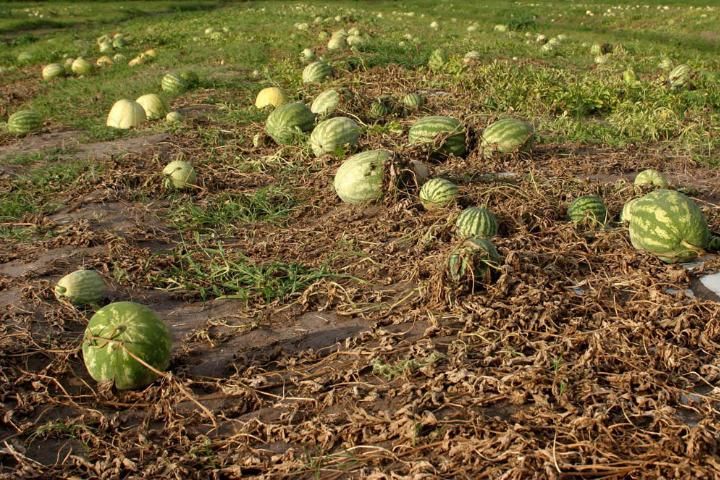
Credit: Pamela Roberts UF/IFAS
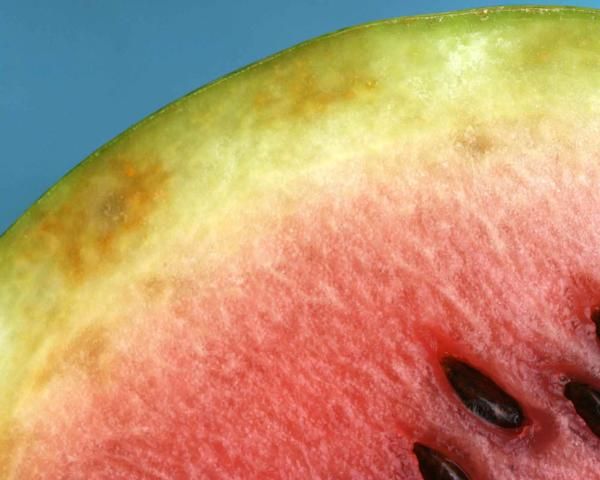
Credit: Pamela Roberts UF/IFAS
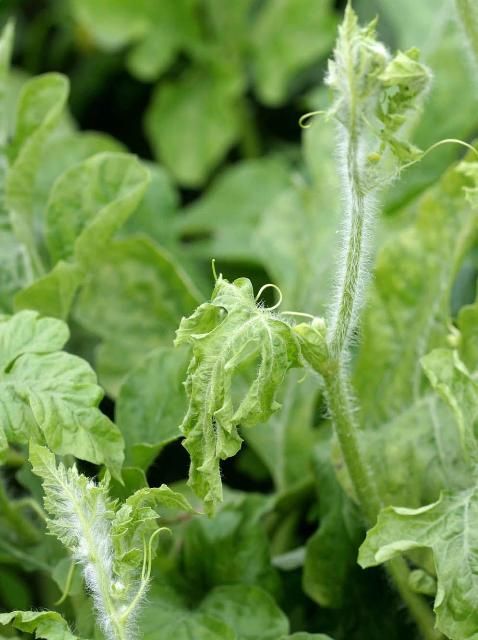
Credit: Pamela Roberts UF/IFAS
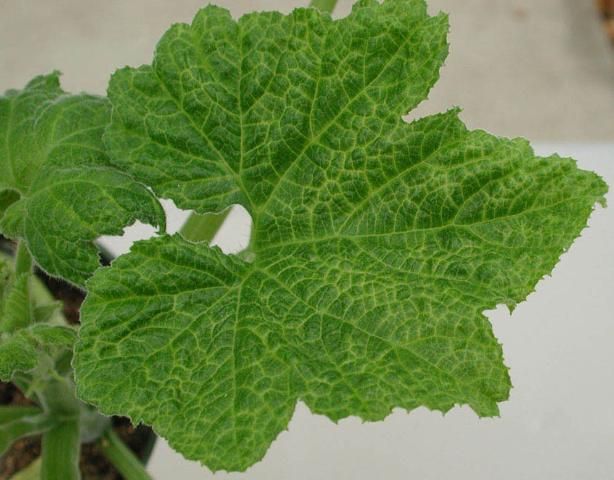
Credit: Pamela Roberts UF/IFAS
Cucurbit leaf crumple virus (CuLCrV) was first recognized in 1998 in the Imperial Valley of California. CuLCrV was first found in northeast and north-central Florida in 2006 but has now spread to other parts of the state. It is a begomovirus in the family Geminiviridae. Once a whitefly acquires CuLCrV, it can transmit the virus for the rest of its life. CuLCrV causes a suite of symptoms primarily characterized by leaf chlorosis, distortion, curling and crumpling, and plant stunting and wilting, leading to significant reduction in total yield. It appears to be more damaging to squash than to cantaloupe and watermelon; however, internal fruit quality issues (discoloration and reduced sugar) have been recently found on CuLCrV-infected watermelon. The fruit of yellow squash plants develop green streaks. In watermelon, yellowing of leaves and crumpling can occur (Figure 5). All cucurbits are susceptible except for acorn and butternut squash and a number of melons, such as galia, honeydew, casaba, and golden crenshaw. CuLCrV has also been found to infect green beans, balsam apple, and smellmelon in Florida (Akad et al. 2008; Adkins et al. 2008, 2009). Other weed hosts have not yet been identified. See https://edis.ifas.ufl.edu/publication/in716 for other photographs of symptoms in squash, watermelon, and snap bean.
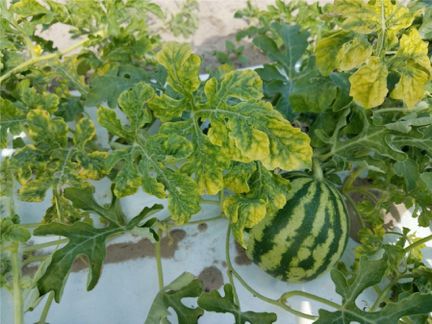
Credit: Xavier Martini, UF/IFAS
Cucurbit yellow stunting disorder virus (CYSDV) was originally reported from the Middle East and Spain. It was first found in the United States in Texas in 1999 and was widespread in the southwestern United States in the fall of 2006 (Brown et al. 2007; Kuo et al. 2007). CYSDV was found in Florida in 2007 (Polston et al. 2008). It is a crinivirus in the family Closteroviridae. CYSDV can persist in the whitefly adult for up to 9 days, the longest time of any crinivirus (Wisler and Duffus 2001). It affects all cucurbit crops, causing reduced fruit size and sugar content. Symptoms resemble those of a nutritional deficiency or water stress; the most obvious symptoms are seen on older leaves. The first symptom is a yellow spotting of leaves (Figure 6). Then, leaves turn yellow between the leaf veins, which remain green—the opposite of what happens when squash is infected with SqVYV. Leaves roll downward and become brittle. It can take up to four weeks for symptoms to develop after infection, so it is easy to move the virus long distances in infected but symptomless transplants without realizing that the plants are infected. CYSDV has also been found infecting smellmelon in Florida (Adkins et al. 2009).
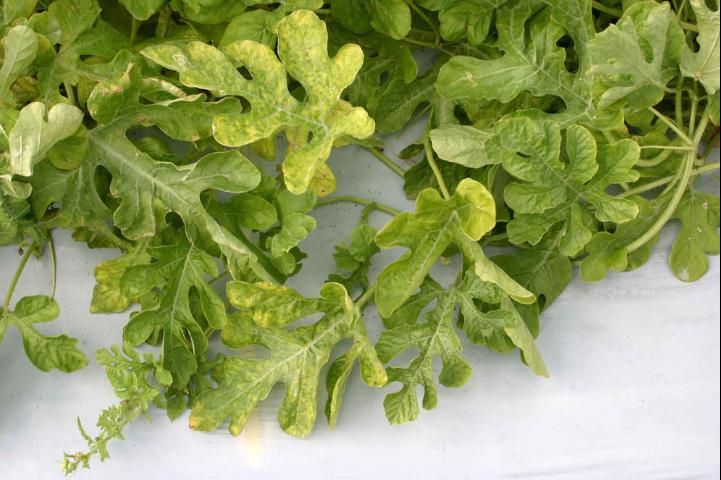
Credit: Pamela Roberts, UF/IFAS
Cucurbit Chlorotic Yellows Virus (CCYV) is the more recent arrival in Florida, as it was first discovered in 2021 in north Florida and identified also in watermelon grown in south Florida (Jailani et al. 2021; Hendricks et al. 2021). It is a Crinivirus in the family Closteroviridae. Symptoms observed include leaf crumpling, yellowing and curling, and vein yellowing. These symptoms are similar to those found in single/and or mixed infection of CuLCrV, CYSDV, and SqVYV. The first outbreak observed had up to 100% disease incidence in the field that led to fruit quality issues and yield losses of 80% and above.
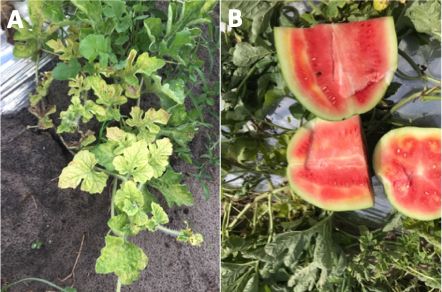
Credit: Mathews Paret UF/IFAS
It is important to note that many of the above-mentioned viruses rarely occur alone and that multiple infections are common.
Management
As of this writing, no cucurbit varieties resistant to these viruses are available. Management of the whitefly vector and weed hosts of the virus is the only option for reducing losses at this time. Whitefly resistance to insecticides is a serious problem with a number of products no longer effective for killing adult whiteflies. Whitefly nymphs are easier to control than adults; this is because adults feed on more than 600 different host plants that include weeds and other cultivated crops. Cultural controls, as outlined below, are essential for a strong resistance management program.
Most of the following management recommendations are taken directly from “Management of Whiteflies, Whitefly-Vectored Plant Virus, and Insecticide Resistance for Tomato Production in Southern Florida,” specifically the recommendations for managing Tomato yellow leaf curl virus (TYLCV) and for delaying the development of resistance to insecticides in the whitefly vector (Schuster et al. 2007). Those sections not relevant to cucurbits have been deleted, and some information has been added. The recommendations for tomatoes have evolved over several years and continue to be revised. We envision a similar process for the recommendations for cucurbits.
Crop Hygiene
Field hygiene should be a high priority and should be included as an integral part of the overall strategy for managing whitefly populations, reducing incidence of whitefly-transmitted viruses, and reducing the incidence of insecticide resistance. These practices will help delay the initial whitefly infestation and delay the introduction of viruses into the crop.
Establish a minimum 2-month crop-free period during the summer, preferably from mid-June through mid-August or longer.
- Delay planting new fall crops as long as possible and remove spring crops as early as possible to increase the summer crop-free period and avoid carryover of disease and pests to the fall crop.
- Try to eliminate, as much as is practical, any cucurbit weeds (balsam apple, creeping cucumber, citron) that could serve as a source of viruses and whiteflies for the crop.
Separate fall and winter cucurbit crops in time and space.
- Do not plant new crops near or adjacent to old, infested crops as whitefly adults tend to migrate from old declining crops toward new crops with emerging leaves.
- If the cucurbit plants are to be a double crop, especially following tomatoes, the previous or primary crop should be thoroughly destroyed to reduce the initial whitefly population.
Destroy the crop and existing whiteflies quickly and thoroughly.
- Promptly and efficiently destroy all vegetable crops within 5 days of final harvest to maximally decrease whitefly numbers and sources of plant viruses.
- Use a contact desiccant ("burn down") herbicide in conjunction with a heavy application of oil (not less than 3% emulsion) and a non-ionic adjuvant to destroy crop plants and to quickly kill whiteflies.
- Time burn down sprays to avoid windy periods, especially when prevailing winds are blowing whiteflies toward adjacent plantings.
- Destroy crops block by block as harvest is completed rather than waiting and destroying the entire field at one time.
Other Cultural Control Practices
Use proper pre-planting cultural practices to avoid introducing whiteflies or viruses into crops.
- Grow and/or plant whitefly and virus-free transplants.
- When possible, plant cucurbits at least 1.5 mile upwind from key sweet potato whitefly hosts such as tomatoes, soybean, and cotton.
- Do not grow, work with, or manipulate vegetable transplants and ornamental plants (i.e., hibiscus, poinsettia) at the same location and at the same time, especially if bringing in plant materials from other areas of the United States or outside the United States.
- If this is not possible, isolate vegetable transplants and ornamental plants from each other.
- Avoid yellow clothing or implements, which will attract whitefly adults.
- Cover all vents and other openings with whitefly-resistant screening (0.25 x 0.8 mm openings or less for passive ventilation, less for forced-air ventilation). Use double doors with positive pressure. Cover roofs with ultraviolet light-absorbing films (UV-absorbing films), or UV-reflecting covers when feasible.
- Covering the ground outside the greenhouse or planthouse, particularly adjacent to greenhouse cooling pads, with UV-reflective mulch can reduce entry of whiteflies, aphids, and thrips. See https://edis.ifas.ufl.edu/publication/in730 for this and other details of exclusion practices.
- If possible, do not purchase transplants produced in Texas, the southwestern United States, or Mexico, where whitefly-transmitted viruses are common.
- Use UV-reflective (aluminum) mulch on plantings that are historically most susceptible to whitefly infestation. Reflective mulches with a black strip (not metalized) down the center to allow the soil to warm will be less likely to delay growth for crops grown in cooler months. The effects of the mulch will be lost when plants cover the mulch.
- Incorporate plants such as sweet alyssum (tall white) and African marigold (crackerjack) that are known to be attractive to beneficial insects and pollinators but are not susceptible to whiteflies.
Use proper post-planting practices.
- Removal of the earliest plants with symptoms may be of some value, especially for reducing the spread of viruses when whitefly populations are low.
- Manage weeds within crops to minimize interference with spraying and to eliminate weeds that can serve as whitefly and virus hosts.
Insecticidal Control Practices
- Use a proper whitefly insecticide program that rotates modes of action to delay the development of resistance to insecticides, particularly neonicotinoid insecticides. Read and follow the label; many insecticides have limits on the number of applications that can be made in a growing season.
- Insecticides that disrupt whitefly feeding should be privileged as they significantly reduce the transmission of virus. These include diamides, neonicotinoids and pyrifluquinazon (Castle et al. 2017).
- On transplants in the production facility, apply a neonicotinoid one time not more than 7 days before planting.
- Use soil applications of neonicotinoids at planting for longer-season crops, such as watermelon, so that there is less chance of affecting bees pollinating the crop. During the rest of the season, avoid spraying neonicotinoids; those can be replaced by diamides or flupyradifurone.
- For best control, use a neonicotinoid as a soil drench at transplanting/seeding, preferably in the transplant/establishment water. Soil applications of neonicotinoids through the drip irrigation system are generally less efficient and wasteful of product and thus not recommended.
- To preserve the neonicotinoid-free period, do not use split applications of soil drenches of neonicotinoid insecticides (i.e., do not apply at transplanting and then again later).
- If foliar applications of a neonicotinoid insecticide (dinotefuran, acetamiprid, and thiamethoxam are labeled for this use on cucurbits) are used instead of soil drenches at transplanting, foliar applications should be restricted to the period before flowering because of toxicity to bees. Do not exceed the maximum active ingredient per season according to the label.
- Follow scouting recommendations when using a foliar neonicotinoid insecticide program. Switch to non-neonicotinoid insecticide classes after flowering begins, and do not use any neonicotinoid class insecticides for the remaining cropping period. The use of insect growth regulators (buprofezin, novaluron, pyriproxyfen) to control nymphs is one effective option. However, keep in mind that growth regulators do not control adults, but nymphs only.
- When possible, use selective rather than broad-spectrum control products, to conserve bees and natural enemies that enhance biological control. Bees are essential for production of cucurbit crops, and insecticides that are toxic to them should be avoided during flowering or applied in the evening when bees are not foraging.
- Use kaolin clay as repellent against whitefly adults in addition to or in alternation with conventional insecticides. Kaolin needs to be applied on the bottom of the leaves for best efficacy, which may not be feasible for crops such as watermelon that grow as a rambling vine. To increase kaolin efficacy, it can be tank-mixed with limonene (5ml/L) and an emulsifier (Johnston et al. 2022).
- Pymetrozine (Fulfill) has been shown to reduce virus transmission of SqVYV in greenhouse studies if both the infected (source of virus) and uninfected plants are treated, so it will be of most value in preventing spread once this virus is present in the crop.
- Do not apply insecticides on weeds on field perimeters. If you are worried that weeds can host whiteflies and their viruses, remove the weeds instead. Applications of insecticides on weeds can kill insect natural enemies and pollinators (weeds have different flowering times than the main crop).
- Apply an effective insecticide to kill whitefly adults prior to any cultural manipulations but apply when bees are not foraging.
Do Unto Your Neighbor As You Would Have Them Do Unto You
Look out for your neighbor's welfare.
This may be a strange or unwelcome concept in the highly competitive vegetable industry, but it is in your best interest to remember—and work to protect—neighboring growers and neighboring crops. Growers must remember that should the whiteflies develop full-blown resistance to insecticides, especially the neonicotinoids, it is not just the other guy who will be hurt—everybody will feel the pain!
Know what is going on in the neighbor's fields.
Growers should try to keep abreast of operations in upwind fields, especially harvesting and crop destruction, which both disturb the foliage and cause whitefly adults to fly. Many crops are hosts for whiteflies, and some of them can be infected by the same viruses that infect cucurbits (e.g., beans and CuLCrV).
For Additional Information
Adkins, S., S. E. Webb, D. Achor, P. D. Roberts, and C. A. Baker. 2007. "Identification and Characterization of a Novel Whitefly-Transmitted Member of the Family Potyviridae Isolated from Cucurbits in Florida." Phytopathology 97:145–154. https://doi.org/10.1094/PHYTO-97-2-0145
Adkins, S., S. E. Webb, C. A. Baker, and C. S. Kousik. 2008. "Squash Vein Yellowing Virus Detection Using Nested Polymerase Chain Reaction Demonstrates That the Cucurbit Weed Momordica charantia Is a Reservoir Host." Plant Disease 92:1119–1123. https://doi.org/10.1094/PDIS-92-7-1119
Adkins, S., C. G. Webster, C. A. Baker, R. Weaver, E. N. Rosskopf, and W. W. Turechek. 2009. “Detection of Three Whitefly-Transmitted Viruses Infecting the Cucurbit Weed Cucumis melo var. dudaim in Florida.” Plant Health Progress 10:1. https://doi.org/10.1094/PHP-2009-1118-01-BR
Akad, F., S. Webb, T. W. Nyoike, O. E. Liburd, W. Turechek, S. Adkins, and J. E. Polston. 2008. "Detection of Cucurbit leaf crumple virus in Florida Cucurbits." Plant Disease 92:648–648. https://doi.org/10.1094/PDIS-92-4-0648C
Brown, J. K., J. C. Guerrero, M. Matheron, M. Olson, and A. M. Idris. 2007. "Widespread Outbreak of Cucurbit yellow stunting disorder virus in Melon, Squash, and Watermelon Crops in the Sonoran Desert of Arizona and Sonora, Mexico." Plant Disease 91:773. https://doi.org/10.1094/PDIS-91-6-0773A
Castle, S., J. Palumbo, P. Merten, C. Cowden, and N. Prabhaker. 2017. "Effects of Foliar and Systemic Insecticides on Whitefly Transmission and Incidence of Cucurbit yellow stunting disorder virus." Pest management science 73 (7): 1462–1472. https://doi.org/10.1002/ps.4478
Hendricks, K., R. N. Hernandez, P. D. Roberts, T. Isakeit, and O. J. Alabi. 2021. “First Report of Watermelon crinkle leaf-associated virus 1 (WCLaV-1) and WCLaV-2 in Watermelon (Citrullus lanatus L.) Plants Co-Infected with Cucurbit chlorotic yellows virus in Florida.” Plant Disease 106 (1): 339. https://doi.org/10.1094/PDIS-06-21-1141-PDN
Hochmuth, Robert C., and Richard K. Sprenkel. 2008. “Exclusion Methods for Managing Greenhouse Vegetable Pests: ENY-846/IN730”. EDIS 2008 (3). https://doi.org/10.32473/edis-in730-2008
IRAC (Insecticide Resistance Action Committee) Website http://www.irac-online.org
Jailani, A. A. K., F. Iriarte, R. Hochmuth, S. M. Willis, M. W. Warren, K. K. Dey, M. Velez-Climent, J. McVay, S. Bag, and M. L. Paret. 2021. “First Report of Cucurbit chlorotic yellows virus Affecting Watermelon in USA.” Plant Disease 106 (2): 774. https://doi.org/10.1094/PDIS-03-21-0639-PDN
Johnston, N., T. Paris, M. Paret, J. Freeman, and X. Martini. 2022. “Repelling Whitefly (Bemisia tabaci) Using Limonene-Scented Kaolin: A Novel Pest Management Strategy.” Crop Protection 155:105905. https://doi.org/10.1016/j.cropro.2022.105905
Kuo, Y. -W., M. R. Rojas, R. L. Gilbertson, and W. M. Wintermantel. 2007. "First Report of Cucurbit yellow stunting disorder virus in California and Arizona, in Association with Cucurbit leaf crumple virus and Squash leaf curl virus." Plant Disease 91 (3): 330. https://doi.org/10.1094/PDIS-91-3-0330B
Polston, J. E., L. L. Hladky, F. Akad, and W. M. Wintermantel. 2008. "First Report of Cucurbit yellow stunting disorder virus in Cucurbits in Florida." Plant Disease 92 (8): 1251. https://doi.org/10.1094/PDIS-92-8-1251B
Schuster, David J., Philip A. Stansly, Jane E. Polston, Phyllis R. Gilreath, and Eugene McAvoy. 2007. “Management of Whiteflies, Whitefly-Vectored Plant Virus, and Insecticide Resistance for Vegetable Production in Southern Florida: ENY-735/IN695.” EDIS 2007 (17). https://doi.org/10.32473/edis-in695-2007
Wisler, G. C. and J. E. Duffus. 2001. “Transmission Properties of Whitefly-Borne Criniviruses and Their Impact on Virus Epidemiology.” In: Virus-Insect-Plant Interactions, edited by K. F. Harris, O. P. Smith and J. E. Duffus. Academic Press, San Diego, CA, USA, pp 293–308. https://doi.org/10.1016/B978-012327681-0/50018-2
Webb, Susan E., F. Akad, Teresia W. Nyoike, Oscar E. Liburd, and Jane E. Polston. 2007. “Whitefly-Transmitted Cucurbit Leaf Crumple Virus in Florida: ENY-477/IN716.” EDIS 2007 (11). https://doi.org/10.32473/edis-in716-2007